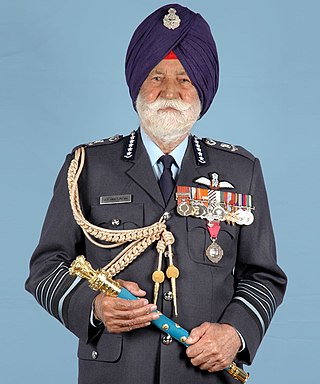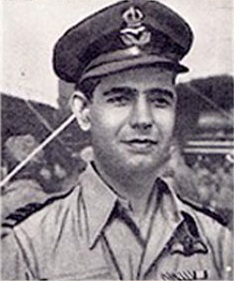Air marshal is an air-officer rank used by some air forces, with origins from the Royal Air Force. The rank is used by the air forces of many countries which have historical British influence, including many Commonwealth nations. The rank is usually equivalent to a vice admiral or a lieutenant general.
Air chief marshal is a high-ranking air officer rank used by some air forces, with origins from the Royal Air Force. The rank is used by air forces of many countries that have historical British influence. This rank is also equivalent to an Admiral in a navy or a full general in an army or other nations' air forces.

Marshal of the Indian Air Force Arjan Singh, was a senior air officer of the Indian Air Force. He served as the 3rd Chief of the Air Staff from 1964 to 1969, leading the Air Force through the Indo-Pakistani War of 1965. He was the first and only officer of the Indian Air Force (IAF) to be promoted to five-star rank as Marshal of the Indian Air Force, equal to the army rank of Field Marshal.
The Indian Air Force (IAF), the aerial component of the Indian Armed Forces follows a certain hierarchy of rank designations and insignia derived from the erstwhile Royal Indian Air Force (RIAF).

Air Chief Marshal Pratap Chandra Lal, DFC was the Chief of Air Staff (CAS) of the Indian Air Force (IAF) during the Indo-Pakistani War of 1971. He served in the IAF from 1939 until his retirement in 1973. He was the CAS at the time of Operation Chengiz Khan, the preemptive strikes that were carried out by the Pakistan Air Force (PAF) that marked the formal initiation of hostilities of the war.

The Vice Chief of the Air Staff (VCAS) is the deputy to the Chief of the Air Staff of India and second-highest ranking officer of the Indian Air Force. The VCAS is a PSO at Air Headquarters at New Delhi. In the event that the Chief of Air Staff (CAS) is absent or is unable to perform his duties, the VCAS assumes the duties and responsibilities of the CAS. The VCAS is normally held by an officer of three star rank and is held by an air officer of the rank of Air Marshal.

The Chief of the Air Staff (CAS) is a statutory office held by the professional head of the Indian Air Force (IAF), the aerial branch of the Indian Armed Forces. Customarily held by a four-star air chief marshal, the CAS is the senior-most operational officer of the IAF, mandated with the responsibilities of supervising the force's overall functioning during states of peace and wartime, committing to the establishment-cum-continuity of air deterrence and executing India's security objectives vis-à-vis the preservation of the country's air sovereignty.

Air Marshal Aspy Merwan Engineer DFC was an officer in the Indian Air Force who rose through the ranks to become independent India's second Chief of the Air Staff, succeeding Subroto Mukerjee in 1960 and preceding Arjan Singh.

Marshal of the Air Force is a five star rank and the highest attainable rank in the Indian Air Force.

General is a four-star general officer rank in the Indian Army. It is the highest active rank in the Indian Army. General ranks above the three-star rank of lieutenant general and below the five-star rank of field marshal, which is largely a war-time or ceremonial rank.

Admiral is a four-star naval flag officer rank in the Indian Navy. It is the highest active rank in the Indian Navy. Admiral ranks above the three-star rank of vice admiral and below the five-star rank of admiral of the fleet, which has never been awarded or held.

Air marshal is a three-star air officer rank in the Indian Air Force. It is the second-highest active rank in the Indian Air Force. Air marshal ranks above the two-star rank of air vice marshal and below the four-star rank of air chief marshal, which is held by the Chief of the Air Staff.

Vice admiral is a three-star flag officer rank in the Indian Navy. It is the second-highest active rank in the Indian Navy. Vice admiral ranks above the two-star rank of rear admiral and below the four-star rank of admiral, which is held by the Chief of the Naval Staff (CNS).

Lieutenant general is a three-star general officer rank in the Indian Army. It is the second-highest active rank in the Indian Army. Lieutenant generals rank above the two-star rank of Major General and below the four-star rank of General, which is held by the Chief of the Army Staff.
Air Vice Marshal Erlic Wilmot Pinto, PVSM was an Air officer in the Indian Air Force. He was the Air Officer Commanding-in-Chief (AOC-in-C) Western Air Command when he was killed in the 1963 Poonch Indian Air Force helicopter crash. He served in the IAF from 1940 until his death in 1963. He was the theatre air commander commanding the air operations during the Annexation of Goa.

Rear admiral is a two-star flag officer rank in the Indian Navy. It is the third-highest active rank in the Indian Navy. Rear admiral ranks above the one-star rank of commodore and below the three-star rank of vice admiral.

Air vice marshal is a two-star air officer rank in the Indian Air Force. It is the third-highest active rank in the Indian Air Force. Air vice marshal ranks above the one-star rank of air commodore and below the three-star rank of air marshal.

Commodore is a one-star rank in the Indian Navy. Commodore ranks above the rank of captain and below the two-star rank of rear admiral. This navy rank will be abbreviated as CMDE or Cmde.

Air Commodore is a One-star rank in the Indian Air Force. Air Commodore ranks above the rank of Group Captain and below the two-star rank of air vice marshal.

Group Captain is a rank in the Indian Air Force. Group Captain ranks above the rank of Wing commander and lower than an Air Commodore. It is equivalent to colonel in the Indian Army and captain in the Indian Navy.


















